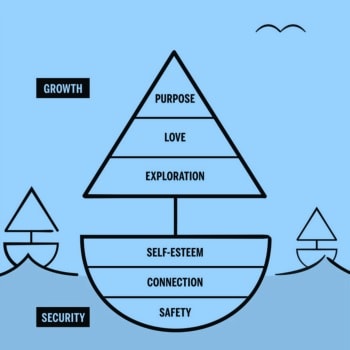Maslow Redux: Connection
4 March 2023
One of the many rewards of reading Kaufman’s (2020) take on Maslow was the biographical sketches such as that of Maslow working as a grad student with Harry Harlow. The chapter on connection, middle band in the boat’s hull, Fig. 1, below, discusses the concern both men had with their contemporary psychologists’ ignorance of love and affection. Both men saw connection as a requirement of healthy development.
Kaufman (2020, p. 38) broke it down this way, “The need for connection actually consists of two subneeds: (a) The need to belong, to be liked, to be accepted, and (b) The need for intimacy, for mutuality, for relatedness.” Secure attachment ensures connection; intimacy is assured only by a high-quality connection leaving both parties feeling vital, alive. In short, “High quality connections affect a variety of life domains, acting as a ‘rising tide’ that enhances the effects of other sources of well-being, such as good physical health, self-esteem, optimism, constructive coping, and perceived control over the environment” (Compton & Hoffman, 2019, in Kaufman, 2020, p. 43).

Figure 1: Kaufman’s revised Maslovian needs.
(Image: Andy Ogden in Harper, 2020).
Something cool, called neural coupling, happens when we connect deeply as social engagements of a meaningful nature implicate our internal opioid-based pleasure system. Simultaneously, some research indicates that our calm-and-connect system hits its powerband while the sensitivity to threats drops a couple notches. This means there’s a kind of natural high that comes with good social connection.
This blog has reported on the loneliness epidemic before. One of the most referenced sources on loneliness, Cacioppo, is quoted stating that “…social isolation has an impact on health comparable to the effect of high blood pressure, lack of exercise, obesity or smoking” (Cacioppo & Patrick, 2008, p. 5 in Kaufmann, 2020, p. 45). Put in plainer terms, “Loneliness poses a risk of mortality comparable to that of smoking and double that of obesity…” i.e., loneliness kills.
So what are we to do? Too many of us seek money, social status, and all those things marketers tell us are required for the good life. Kaufman looked at money and social media, giving both indifferent marks. As someone who had lost most of his equity once said to me, “It’s easy to dismiss your security when you’ve got money.” I agree. There’s a certain baseline of bread that varies person to person, family to family, which sets a survival level. After that, the utility of more money is arguable.
Social media was summed up thus: “[It] simultaneously enlarges the possibility of forming loving relationships while also making it easier to avoid forming meaningful ones” (Kaufman, 2020, p. 51). It seems to foster that fear of missing out (FOMO) thing where you sometimes feel you’re the only one not invited to the party, while other times social media provides an almost global sense of connectedness.
This has real meaning for most of the folks I believe are reading this blog, those with addiction or from families suffering addiction. As Gabor Maté and Johann Hari have emphasized, the opposite of addiction isn’t sobriety—the opposite of addiction is connection.
Kaufman (2020, p. 52) also added that “The need for connection is most likely to be satisfied when we have secure, stable, and intimate connections with at least a few people in our lives…However, when our need for connection is severely thwarted, we tend to display a much more insecure need for belonging and care much more about status and popularity” (last half from Lavigne et al., 2011). Of course, the sad kicker here is that living with another is not necessarily connection (Kaufman, 2020, p. 41).
So what’s the takeaway? Connection not only saves lives, it gives those living those lives another soul to care about, relate to, and to see and be seen by. Bottom line, if that ain’t happening, get out there and be with more people more often. Connection is an essential part of well-being. “When one feels belonging, one feels accepted and seen [visible], and when one is deprived of belonging, one feels rejected and invisible (Kaufman, 2020, 38).
Dan Chalykoff is working toward an M.Ed. in Counselling Psychology and accreditation in Professional Addiction Studies. He works as a supervised psychotherapist at CMHA-Hamilton where his primary focus is trauma. He writes these blogs to increase (and share) his own evolving understanding of ideas. Since 2017, he has facilitated two voluntary weekly group meetings of SMART Recovery. Please email him (danchalykoff@hotmail.com) to be added to or removed from the Bcc’d emailing list.
References
Kaufman, S. B. (2020). Transcend: The new science of self-actualization. TarcherPerigee Books.
Lavigne, G. L., Vallerand, R. J., & Crevier-Braud, L. (2011). The fundamental need to belong: On the distinction between growth and deficit-reduction orientation. Personality and Social Psychology Bulletin, 37(9), 1185-1201.
Comments